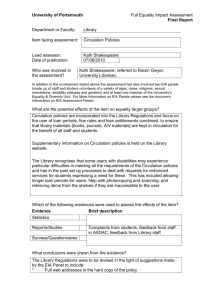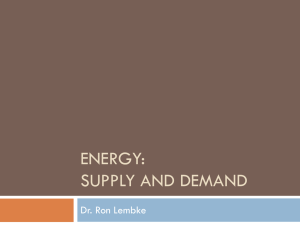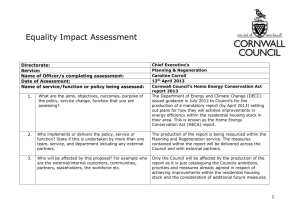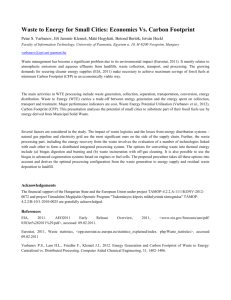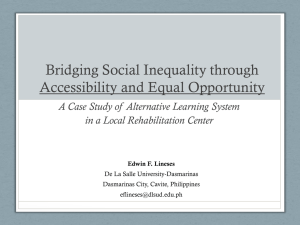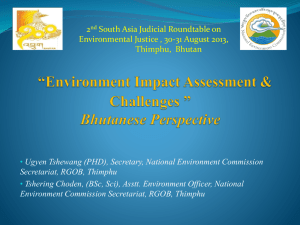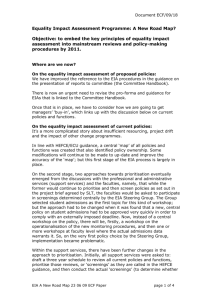EIA Communications and Marketing Cover Report
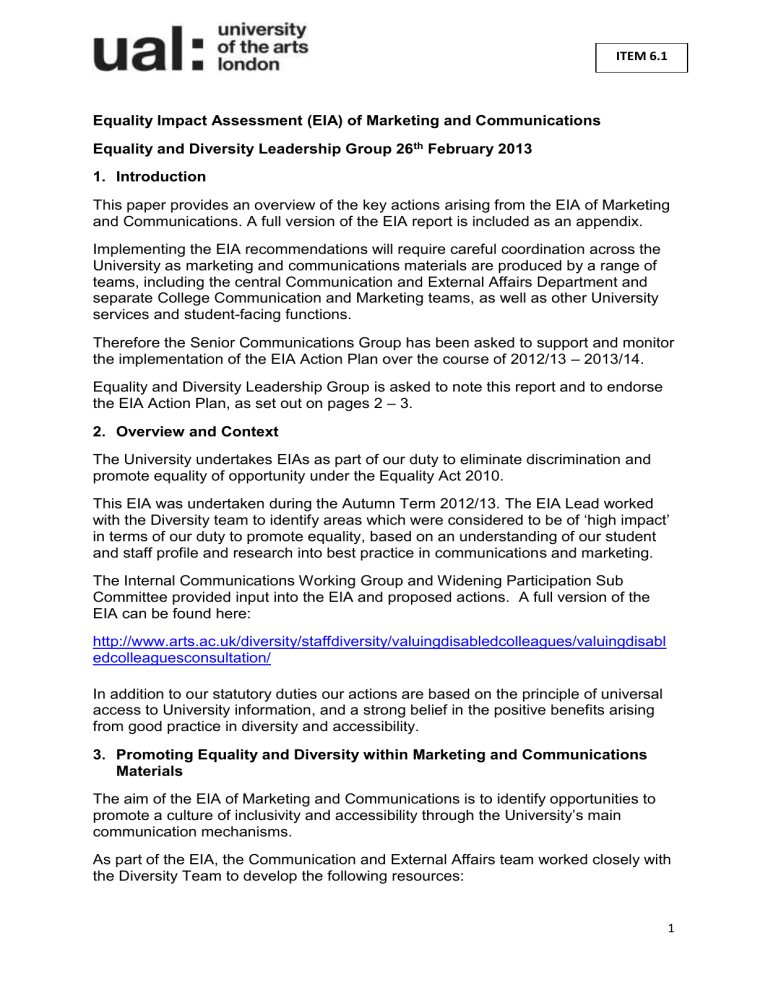
ITEM 6.1
Equality Impact Assessment (EIA) of Marketing and Communications
Equality and Diversity Leadership Group 26 th February 2013
1. Introduction
This paper provides an overview of the key actions arising from the EIA of Marketing and Communications. A full version of the EIA report is included as an appendix.
Implementing the EIA recommendations will require careful coordination across the
University as marketing and communications materials are produced by a range of teams, including the central Communication and External Affairs Department and separate College Communication and Marketing teams, as well as other University services and student-facing functions.
Therefore the Senior Communications Group has been asked to support and monitor the implementation of the EIA Action Plan over the course of 2012/13 – 2013/14.
Equality and Diversity Leadership Group is asked to note this report and to endorse the EIA Action Plan, as set out on pages 2
– 3.
2. Overview and Context
The University undertakes EIAs as part of our duty to eliminate discrimination and promote equality of opportunity under the Equality Act 2010.
This EIA was undertaken during the Autumn Term 2012/13. The EIA Lead worked with the Diversity team to identif y areas which were considered to be of ‘high impact’ in terms of our duty to promote equality, based on an understanding of our student and staff profile and research into best practice in communications and marketing.
The Internal Communications Working Group and Widening Participation Sub
Committee provided input into the EIA and proposed actions. A full version of the
EIA can be found here: http://www.arts.ac.uk/diversity/staffdiversity/valuingdisabledcolleagues/valuingdisabl edcolleaguesconsultation/
In addition to our statutory duties our actions are based on the principle of universal access to University information, and a strong belief in the positive benefits arising from good practice in diversity and accessibility.
3. Promoting Equality and Diversity within Marketing and Communications
Materials
The aim of the EIA of Marketing and Communications is to identify opportunities to promote a culture of inclusivity and accessibility through the University’s main communication mechanisms.
As part of the EIA, the Communication and External Affairs team worked closely with the Diversity Team to develop the following resources:
1
A suite of best practice guides on Accessible Communications, Inclusive Events and Web Accessibility. These guides were developed with input from the
University’s Disability Service, Libraries and Learning Resources and CLTAD.
A section was added to the Style Guide to address ways of promoting diversity through images and establishing a clear brand narrative around diversity within marketing materials. The Style Guide also includes standards in relation to accessibility.
The University will launch a new digital environment in September 2013. The web team within the Communication and External Affairs Department are working to ensure a more usable, accessible website for all internal and external communities. Having worked closely with user experience agency Webcredible – an agency with a strong reputation for digital accessibility expertise – on the navigation and structure of the site, we will continue to embed accessibility in design, development and content management.
The new site will be rigorously tested across different browsers, devices and screen readers, as well as with focus groups that will include users with specific learning difficulties and disabilities, and improved training and guidance based on the W3’s Web Content Accessibility Guidelines 2.0 will be shared with all
University and College web editors ( www.w3.org/WAI/WCAG20/quickref/ ).
4. EIA Action Plan
Objective 1: Implement accessible communication standards across UAL
1. Ensure the Accessible Communications guidelines are adopted by Senior college marketing / Communications Teams. Communications
Group
2. Continue to collate examples of good practice in accessible communications and build a network of ‘Accessible Communication
Champions’.
3. Building on the outcomes of the Learning and Teaching Day, take steps to promote best practice in accessible communications to course teams e.g. through the review of Course Handbooks.
Internal
Communications
Working Group.
CLTAD
4. Explore staff development opportunities to help publicise accessible communication, for example, through inviting speakers from TechDis to an Internal Communications Group meeting.
Internal
Communications
Working Group.
Objective 2: Promote best practice in web accessibility
5. Work with Libraries and Learning Resources, the Student Union, the Diversity Team and the Disability Service to identify ways of ensuring disabled students and staff are included within user testing groups for the development of the new website and the development of Moodle.
Web Team CLTAD
6. Building on the approach taken to the UAL Website development project, develop ‘web accessibility’ guidelines which can be shared with other teams and departments across UAL.
Web Team
2
Objective 3: Promote a culture of clear writing across UAL, drawing on Plain English standards where relevant
7. Work with the Language Centre, Widening Participation Teams,
CLTAD and course teams to identify ways of promoting a clear writing culture across UAL.
Communications and Marketing
Objective 4: Ensure the University’s marketing materials reflect the University’s commitment to equality and diversity
8. Promote the diversity guidelines set out in the University’s Style
Guide.
Communications and Marketing
9. Encourage staff to upload images relating to a diversity theme onto the UAL image bank and to ‘tag’ them with reference to a particular diversity theme so that these can be used within University publications.
Diversity Team
Communications and Marketing
Diversity Team
3
